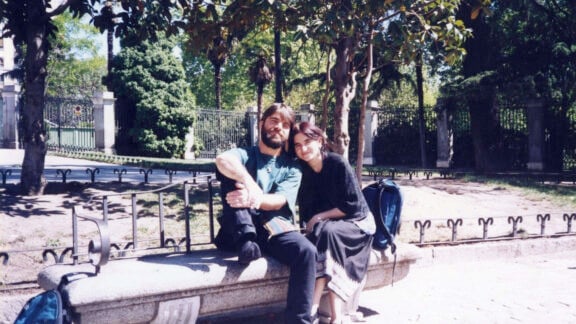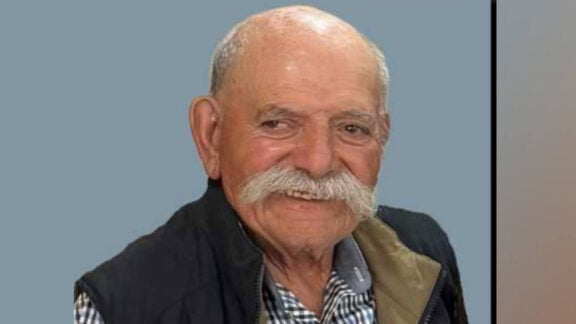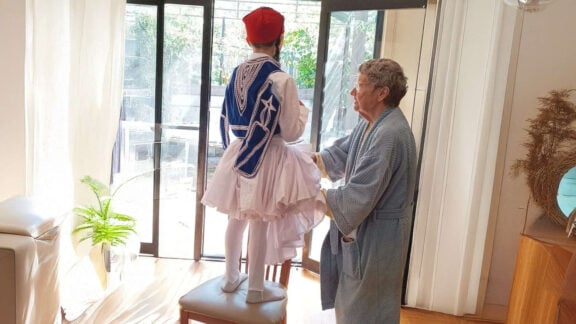The love story of Xanthoula and Herbert “Slim” Wrigley is one of the highlights of the Shrine of Remebrance exhibition entitled: “Lust. Love. Loss. Australian stories of wartime relationships” that is set to run until November.
Their story, one of love, was kindled beyond the grim realities of war and oceans of space and time. It has been told before in this newspaper and in others, the only surprise is that there is no book or screenplay to tell it to the wider world. The exhibition also reflects on the relationships shaped by war of Julia and Jai Michel, of Motoe Higashida and Ian Robertson and of Afghanistan veterans Corporal Neal Fischer and Private Brychan Hawker.
As the exhibition suggests, there are stories of love but also of lust and loss. Armies do not march on their stomachs alone (as Napoleon once said). The world’s “oldest profession”, prostitution, has long thrived where wars are fought. And the exhibition reflects on this aspect of war also.
In the First World War, when Australia sent 334,000 troops to fight in Europe and the Middle East, 55,000 soldiers, roughly a sixth of the army, were treated for venereal diseases like syphilis and gonorrhoea. In an effort to control the problem, the army tried to regulate the brothels, set up clinics and officers held regular “genital” inspections on the parade ground.

The discovery of penicillin before the start of the Second World War was significant. It proved effective not only against wound infections but also venereal diseases. It also made soldiers more complacent so that the percentages of VD infections among Australian troops fighting in Korea, Malaysia and Vietnam were even higher than in the First World War.
The curator of the exhibition, Neil Sharkey told Neos Kosmos that he first turned to the Ancient Greeks for inspiration.
“When I started thinking about the exhibition, some of my early thoughts revolved around the personification of love and war. The Ancient Greeks had a concept of this and an early title for the exhibition was to have been ‘Ares and Aphrodite’. In ‘The Iliad’, the god of war and goddess of love are lovers who are trapped in a net by Aphrodite’s husband Hephaestus and displayed before to the scandalised gods of Mount Olympus. The Trojan war is sparked when a love-struck Paris takes Helen to Troy.”
“The Ancient Greeks had a concept of love and war: a conjunction of powerful emotions, love and sexual power shaped by the killing, destruction and mayhem of war,” Mr Sharkey said. “It is a very broad topic for this exhibition which covers many aspects of Australian military history.”

Mr Sharkey said he has personally known Xanthoula Wrigley for 10 years and the story of her relationship with her late husband, Slim (he died in 1995) had featured in two previous Shine of Remembrance exhibitions.
“Their relationship would not have existed without the war,” Mr Sharkey said. “It is an amazing story that has attracted media attention.”
A month before Nazi Germany began its invasion of Greece on 6 April, 1942, Australia sent 17,000 soldiers of the 6th Division along with troops from New Zealand and Britain to bolster Greek defences in Northern Greece.
Sergeant Slim Wrigley was captured and held at a prisoner of war camp in Thessaloniki. He escaped in September and fled southwestwards to eventually finding safety for the next six months in the home of school teacher Ioannis Papapopoulos in the remote Central Macedonian village of Ritini. The schoolteacher’s daughter, then 14, was Xanthoula.

During that time Sgt Wrigley worked with the Greek Resistance and eventually escaped through neutral Turkey to rejoin the Allied forces in the Middle East. Mr Papapdopoulos who was also involved with the Greek Resistance was captured by the German Gestapo and executed in January 1944.
Five years after the death of her father, Xanthoula Papadopoulou was looking at family photographs when a piece of paper fell out from the batch in her hand. The note contained the name of Herbert Wrigley as well as his Yarraville address.
Xanthoula’s mother urged her daughter, who was learning English, to write to Slim.
A few weeks later, a letter came from Slim. The two began a correspondence that went on for a year. Xanthoula accepted an invitation to visit him in Australia to see if their relationship could develop beyond letter writing. He promised that he would pay for her return if things did not work out. They did.
Five weeks after arriving in Australia the couple married in a Greek Orthodox church in Melbourne.
The couple had two children and their happy marriage lasted until his death 45 years later.







